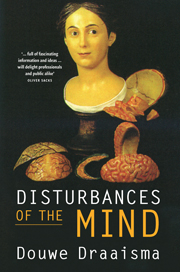Book contents
- Frontmatter
- Contents
- Introduction
- 1 Towards dusk the images appear
- 2 A tormenting round of tremors
- 3 Phineas Gage’s posthumous stroll
- 4 The Celestine prophesy
- 5 Sparks from a Leyden jar
- 6 Siberian brandy
- 7 Go to hell, idiot! Gilles de la Tourette syndrome
- 8 A labyrinth of tangles
- 9 The Mercator of neurology
- 10 The headquarters of madness
- 11 A cup of tea for the doppelgänger
- 12 Little professors
- 13 The Cardan suspension of science
- Index
- References
8 - A labyrinth of tangles
Alzheimer’s disease
Published online by Cambridge University Press: 05 March 2014
- Frontmatter
- Contents
- Introduction
- 1 Towards dusk the images appear
- 2 A tormenting round of tremors
- 3 Phineas Gage’s posthumous stroll
- 4 The Celestine prophesy
- 5 Sparks from a Leyden jar
- 6 Siberian brandy
- 7 Go to hell, idiot! Gilles de la Tourette syndrome
- 8 A labyrinth of tangles
- 9 The Mercator of neurology
- 10 The headquarters of madness
- 11 A cup of tea for the doppelgänger
- 12 Little professors
- 13 The Cardan suspension of science
- Index
- References
Summary
In the photographs taken of her in 1902, Auguste Deter looks older than her 52 years. Her husband has brought her to the psychiatric clinic in Frankfurt am Main, because he is no longer able to care for her at home. Auguste is confused and restless. She suffers from paranoia and is convinced that her husband is carrying on with the woman next door. At times she doesn’t even recognize him as her husband. The family doctor notes in his referral that her memory is seriously affected, and that she suffers from insomnia. His diagnosis is ‘paralysis of the brain’. On 26 November 1901, the day after her admission, Alois Alzheimer has a conversation with his new patient. The first sentence in the dossier reads: ‘Sitting up in bed, expression distraught’. He asks her what her name is. ‘Auguste’. Last name? ‘Auguste’. What is your husband’s name? ‘I think it’s Auguste’. Are you married? ‘To Auguste’. When Alzheimer asks her how long she has been there, she says ‘three weeks’. He shows her various objects: a pencil, a pen, a key, a cigar. She is able to identify them, but shortly afterwards when Alzheimer asks her to name the objects without showing them to her, she has forgotten everything. When the noon meal (cauliflower and pork) is served, he asks her what she is eating. ‘Spinach’. He asks her to write down ‘Mrs Auguste Deter’, but after ‘Mrs’ she’s forgotten what she was supposed to write. Two days later, Alzheimer notes on her chart: ‘Constantly distraught, anxious’, and a day later ‘distraught, resists everything’. He asks her where she thinks she is now, when she was born, what her name is. She is unable to answer any of the questions. Auguste would ultimately spend almost five years in the clinic. Towards the end she lay in bed, dazed and incontinent, her legs drawn up, in a condition which Alzheimer described as ‘total feeble-mindedness’.
- Type
- Chapter
- Information
- Disturbances of the Mind , pp. 199 - 228Publisher: Cambridge University PressPrint publication year: 2009
References
- 2
- Cited by



